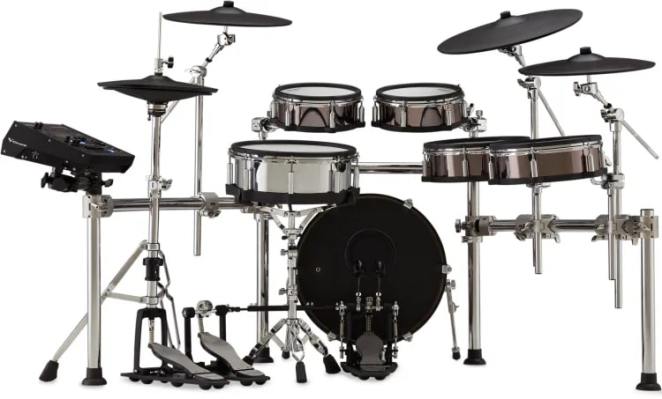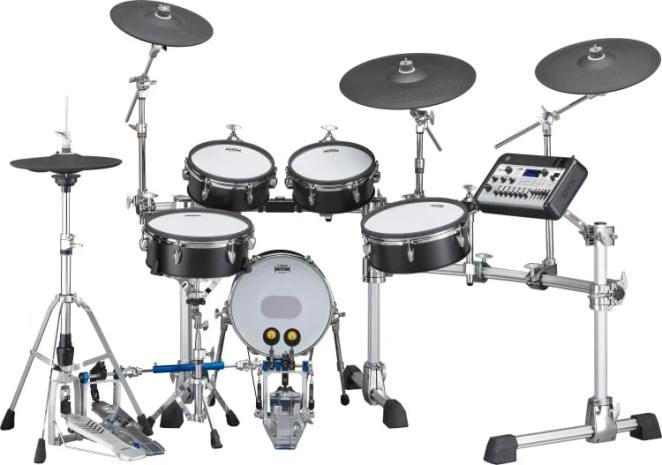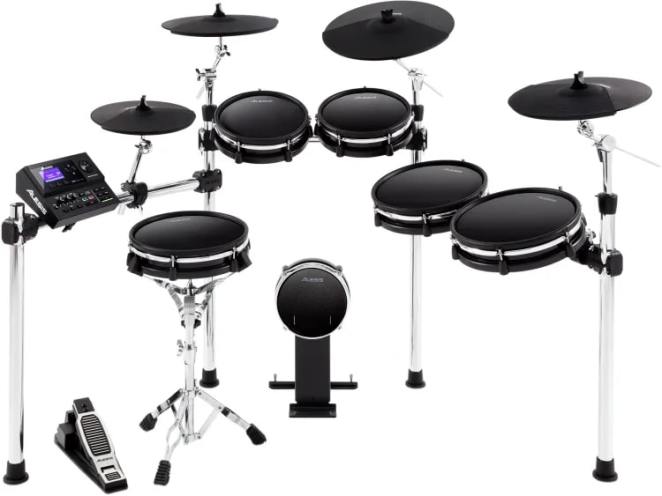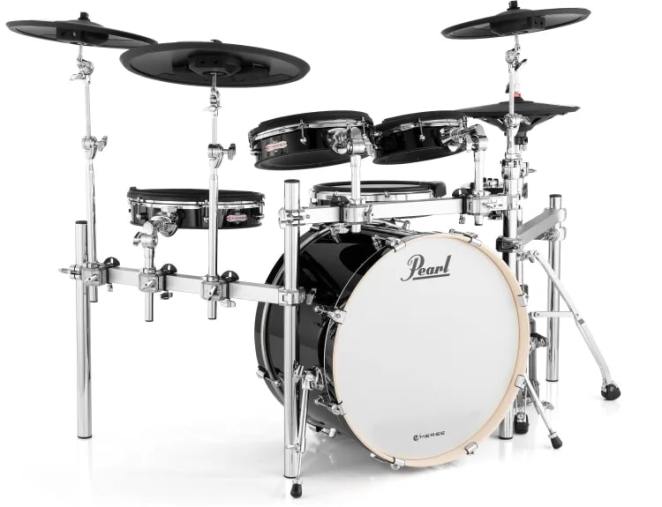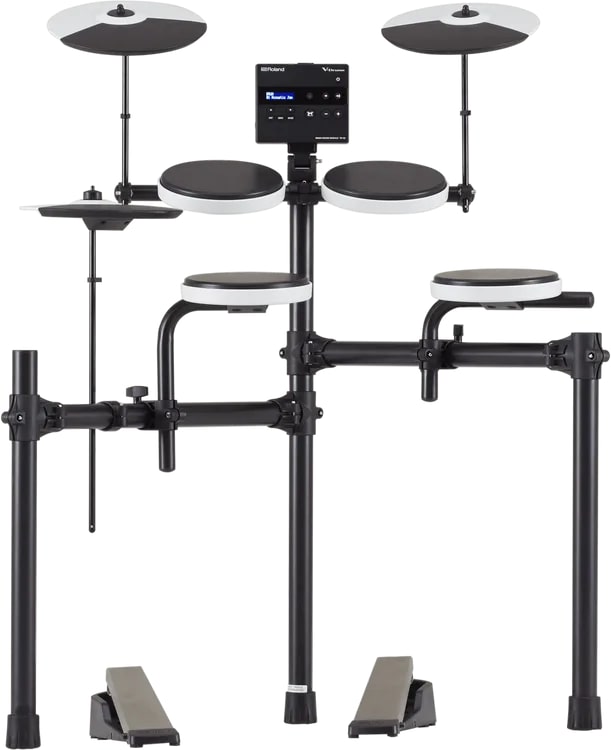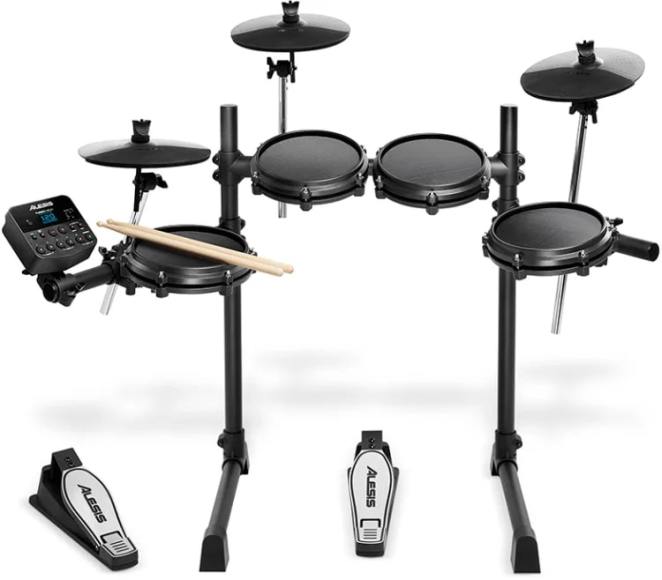When you buy through our links, we may earn an affiliate commission.
Let’s face it – drummers have to deal with a lot. Aside from being the glue that holds a good band together, just playing the instrument is challenging. There are a lot of pieces, it’s cumbersome to move and set up all the time, and the biggest headache? Finding a space to play them!
Electronic drum sets address a lot of these concerns. Different drum sounds in a single kit, easier mobility, quieter operation, and some even offer advanced practice tools to keep your drumming skill sharp without disturbing everyone within earshot.
These are our picks for the best electronic drum sets of 2024.
Quick Summary of the Best Electronic Drum Sets
- Roland V-Drums TD-50KV2 (Best Electronic Drum Set Overall)
- DW DWe 5-piece Drum Kit Bundle (Best Acoustic/Electronic Drum Set)
- Yamaha DTX10K-M (Best Electronic Drum Set for Recording)
- Alesis DM10 mkII Pro (Best Customizable Electronic Drum Set)
- Pearl e/Merge e/Hybrid Electronic Drum Set (Best Hybrid Electronic Drum Set)
- Roland V-Drums TD-02K (Best Entry-Level Electronic Drum Set)
- Alesis Turbo Mesh (Best Budget Electronic Drum Set)
Best Electronic Drum Sets
Best Overall
SPECS
- Number of pads: 6x drum pads, 18” KD-180 kick drum pad, 4x cymbal pads
- Number of kits: 70
- Module I/O: ¼” and ⅛” inputs and outputs, 1x MIDI USB type B, 3x MIDI USB type A
Roland is one of – if not the – premier names in quality electronic drums. And the TD-50KV2 model comes with a mind-boggling amount of awesomeness that rival models can’t come close to competing with.
At this kind of staggering price point, it goes without saying that the response of the drum and cymbal pads rivals even the highest-quality acoustic drum kits, especially the centerpiece of any great kit – the snare.
But the main act of this show is the TD-50X drum module. Flexibility is its key focus. You can send pre-mixed sounds for recording or live performance, and each kit piece has its own output. This makes it easy to process them individually. Record to MIDI, use sample replacement or record up to 32 channels. The possibilities are virtually limitless.
There’s no denying it, this kit is very expensive. But if you are looking to invest in an incredibly well-crafted electronic drum kit the value, sound quality, responsiveness of the kit pieces, and insane amount of options it offers makes it one of the best investments you can make in electronic drums.
Best Acoustic/Electronic
SPECS
- Number of pads: 4x cymbal pads, 4x acoustic snare, mounted toms, floor tom, and kick drum acoustic shells
- Number of kits: N/A
- Module I/O: 1x ⅛” TRS input, 2x ¼” output, 1x ⅛” headphone output, 1x USB-C
Another powerful but pricey model, the DWe combines the feel and articulation of an acoustic drum kit with the convenience of an e-drum kit. It’s “convertible”, which means you can use it as an acoustic or electric kit depending on the situation.
All shells are 9-ply maple that provide the warm, yet cutting tones expected from an acoustic kit. DW didn’t skimp on the hardware either, staying true to the stellar reputation of their gear. The most innovative feature is that the heads are swappable. Electronic heads are wireless, and the triggers offer some of the lowest latency you’ll find in drums like this.
This kit defines the word versatile. Even if you’re using it as an electric, it has the classic appealing aesthetics you're used to if you play acoustic drums. It’s a drummer’s dream, however it’s being used.
Best for Recording
SPECS
- Number of pads: 5 drum pads, 4 cymbal pads
- Number of kits: 70 onboard, 200 user presets
- Module I/O: 11 ¼” trigger inputs, ¼” and ⅛” auxiliary inputs, two ¼” master outputs, four ¼” individual outputs, ¼” and ⅛” headphone outputs, MIDI input/output/USB, USB type A and B
High-value electronic drum kits don’t reduce all of the headaches of lugging acoustic drums to recording sessions. If you’re a gigging musician you play all kinds of venues, and factoring in the additional setup required to play live, some are best kept for the safe harbor of the recording studio.
Recording means you need a kit that can handle any sound and style, and this model is tailor-made for that. Once you pick the right kit sounds, the in-depth controls allow for dialing in the perfect mix of different parameters.
If you want to step outside the options the large library of drum sounds offers you can load up to 1,000 custom samples and percussion sounds to turn this kit into anything. It’s not just for recording though. Different output options make it easy to load into the venue to plug and play.
Yamaha nailed it – this is what electronic drums should be. The mesh pads have dual zone response for a realistic feel, and the 3-zone cymbals have the swing of the real thing. Hardware is professional quality, and everything from the physical setup to the sounds can be customized.
Most Customizable
SPECS
- Number of pads: 6x drum pads, 4x cymbal pads
- Number of kits: 50 preset kits, 30 user kits
- Module I/O: Two ¼” and DB25 trigger inputs, ⅛” auxiliary input, two ¼” analog outputs, MIDI, USB type A and B
Customization is one of the most appealing benefits of electronic drums. Alesis’ DM10 MKII provides the perfect platform for setting up and arranging your e-kit in whatever way works the best for you.
The kit is massive, with 10 pieces in total. Included are a 12” dual-zone snare pad, 8” bass drum pad tower that supports a double bass drum pedal setup, dual 10” rack tom and 12” floor tom pads. For cymbals, the hi-hats are 12”, there are two 14” crashes, and a triple-zone 16” ride cymbal.
Built-in recording functions let you record directly to the drum module or output signals to a digital audio workstation or mixer for playing live. The hardware is built well, with a chrome rack and snare stand that offer support for even the heaviest hitters.
Included are everything you need to get started like drumsticks, a drum key, cabling, and a power supply. For drummers looking for an electric drum kit that comes with different ways to customize the drum sounds and the kit ergonomics this is the perfect choice.
Best Hybrid Set
SPECS
- Number of pads: 5x drum pads, 3x cymbal pads
- Number of kits: 35 preset, 50 user
- Module I/O: DB-25 and three ¼” trigger inputs, ⅛” auxiliary input, two ¼” TRS master outputs, eight ¼” direct outputs, ⅛” headphone output, MIDI, USB type B and type A
Some drummers work only with electronic sets; others need a hybrid of acoustic and electric elements. The e/Merge from Pearl is an impressive feat of what can happen when one of the most respected acoustic drum manufacturers adds in electronic drum functionality.
This collab between Pearl and Korg offers poplar drum shells and durable hardware. It looks like an acoustic drum kit and performs like one. The drum module has 700 sounds and 35 preset kit packs that are a mix of live samples of modern and vintage Pearl kits with the addition of Korg samples that span decades.
The 6-layer PUREtouch pads provide the speed and accuracy you’d expect from an acoustic drum set, with different articulations depending on where on the pad you strike. The snare pad is always the main kit piece that electronic drums are judged by, and through Wave Trigger technology the snare on this kit is as realistic as it gets.
Sixteen GB of onboard memory means you can record directly. You can import WAV sample files through a USB connection, and the drum module has analog and digital outputs that allow for connection to digital or analog devices.
Best Entry-Level
SPECS
- Number of pads: 4 drum pads, kick pad, 3 cymbal pads
- Number of kits: 16
- Module I/O: 1x ⅛” TRS input, 1x ⅛” TRS output, MIDI USB, Bluetooth
Most of our choices for the best electronic drum sets so far are targeted at advanced-level players with plenty of budget to invest in a high-quality kit. But what about new players and beginners? There’s got to be some solid options for them, right?
That’s where Roland’s TD-02K kit comes in. Compared to some other electronic drum kits it’s slimmed down, but that doesn’t mean it can’t compete with them. It’s got four drum pads, three cymbal pads for hi-hat and crashes, and two pedal controllers for the bass drum pedal and hi-hat clutch.
The drum module is slimmed down if you run it up against higher-end models, but it offers 16 prebuilt kits, a metronome for keeping steady time, different rhythm types and variations, and five coaching modes to use for learning and rehearsal.
It’s not without its downsides though. The rack is pretty durable, but even with the benefit of its reduced footprint it only allows for so much give when angling the kit pieces horizontally and vertically.
This could be an issue for drummers that need more from their physical setup. But as an intro kit for those looking at buying an entry-level electronic drum kit the TD-02K is as functional as it is affordable.
SPECS
- Number of pads: 4x drum pads, 3x cymbal pads (hi-hat and two crashes)
- Number of kits: 10 preset kits, five general MIDI kits
- Module I/O: DB-25 trigger input, ⅛” auxiliary input, dual ¼” TS analog outputs, ⅛” headphone output, USB type B
Alesis, one of the pioneers of electronic drum machines and sounds, has been making great equipment for decades.
This five-piece kit has mesh heads that let a drummer’s flair translate. They’re all tuneable, so the player can dial in their own sensitivity and rebound based on preference.
The module offers the varying drum sounds players need that cover all genres and styles. It doesn’t have a lot of preset slots, but 10 should be more than enough to get you going.
And if you’re looking to keep your skills sharp or are just starting out on your drumming journey it offers practice tools like an onboard metronome and drum coaching exercises.
At just under $300 (new), this kit brings value even with the drawbacks you’d expect from the price point. The snare drum is only 8” and has a single-zone, so it’s not nearly as responsive as other models on our list.
There aren’t many preset kit options, but with 120 sounds to choose from you can put together the ones that work best for you.
Best Electronic Drum Sets Buyer's Guide
Drums are a unique instrument, and finding the perfect kit for you takes research and understanding of what you need to get out of it.
Here we break down some of the features that separate the good from the bad, and why they are an important consideration in your buying decision when shopping around for a new electronic drum kit.
Module
Drum modules are the heart and soul of any electronic drum set. In base models it just provides the sample sounds and routing. But in more robust options like the Roland V-Drums TD-50KV2 or the Yamaha DTX10K-M it is a dynamo.
This essential electronic kit piece is the brain that lets you build kits, assign sounds to drum and cymbal pads, and even upload custom samples with external media devices.
When it comes to routing, modules range from balanced stereo outputs and maybe an auxiliary or headphone output to individual outs for every kit piece, MIDI and USB connections, and more.
Along with the sensitivity response of the pads, how powerful the module is makes this one of the most important things to research when shopping around for a kit.
Sound Library
One of the biggest appeals of electronic drums is the different kit sounds that come with the libraries. They allow players to mix and match kit pieces to build the perfect setup.
The sound library will depend on the quality of the drum module. Lower-end models will offer basic sounds, but some of them might sound too “plastic” and not realistic. Sometimes you want an electronic kit to sound like one, but it’s also useful to be able to access realistic acoustic drum set sounds as well along with some percussions like a standard cajon, bongos, congas, and djembe.
Lastly, do you want to have the option of using your own custom sounds and samples? Some kits allow you to import files, which is useful beyond drums. You can use the pads and cymbals to trigger all kinds of sounds!
The best electronic drum sets offer a variety of different acoustic and electric drum sounds. What’s even better are those that let you build and customize kits and import your own samples.
By uploading custom samples to the module you can use the pads to trigger sounds that go way beyond drums. Sound effects, pre-processed samples, virtual instruments, the possibilities are endless. This is a great way to get utility out of your kit or use it to augment your acoustic drums setup.
Kit Pieces
Like acoustic drums, the kit pieces of electronic drum sets are an important consideration when drummers are shopping around for the right model for them. It’s not just the amount of sounds that can be accessed, it’s the quality.
High-quality kit pieces offer multi-zone sensitivity and sensors that respond like acoustic drums. This is especially true with the snare since it’s the most important part of any drum kit. Even budget models are improving the way their kit pieces respond to the drummer’s playing.
Additional Features
All electronic kits have similarities, but when it comes to additional features they start to separate pretty quickly.
Some things to keep in mind when you’re in the market to buy one include onboard effects processing and recording functions. These make it easy to create and document your ideas anywhere. You can then get them into your recording projects to work on them more in-depth.
And if you’re a beginner or just want the option to keep your skills sharp, learning resources like a metronome or lessons make it easy to do that.
Frequently Asked Questions (FAQs)
Are electronic drum sets worth it?
Electronic drums offer a number of advantages over acoustic kits. They provide drummers a way to practice at a reduced volume and the modules allow for kit customization, effects processing, and advanced ways to route the signals.
Price point is the most determining factor in finding an electronic kit that comes with the features you want. Expensive kits can run well into the thousands, but the quality of the product offering isn’t in question.
Models that only cost a few hundred dollars can be great for beginners or if you want an e-kit to just play around with. But that budget might be better served on a higher quality kit.
What are the best brands for electric drum sets?
Electronic drums are unique when it comes to the brands that make them. Some like Alesis and Roland kits are only e-drums. But respected acoustic brands like DW, Pearl, and Yamaha have gotten into the game, and the innovations they’ve made to the instrument give players new ways to realize what electronic drums are capable of.
How do I choose a good electronic drum set?
With so many models to choose from, a good electronic drum set has features that separate it from the rest. When you’re shopping around look for things like multi-zone, responsive pads and cymbals. This is especially true for the snare. Roland V-Drums TD-50KV2 has an 8-zone snare that’s designed to have the articulation of an acoustic.
A versatile module is one of the most important features too. You want one with plenty of sound options, I/O, and some even let you upload your own samples! Like with acoustic drums, good hardware is essential for adding longevity to the kit life.
Do electronic drums sound like real drums?
Today’s electronic drum kits can sound just as authentic as acoustic drums. A lot of modules even let you upload your own samples, which can be anything. Realistic acoustic drums, heavily effected pads, the only limitations are what the modules can do.
With how far electronic drum sets have come, the question isn’t “do they sound real?” anymore. It’s “do they feel real?” High-end kits have responsive pads with multiple sensor zones that respond like real drums, but lower-end models might not offer features like that.
Conclusion
The best electronic drum kits offer so many advantages that every drummer should consider having a reliable one.
From the convenience of quieter practice to the possibility of being able to build any type of kit around the sounds you want, process them, and output them in different ways it’s useful for every drummer to have one.
Keep in mind that budget really matters here. Where you can get a stellar professional-sounding acoustic kit in the $700 to $1,000+ range, an e-drum kit doesn't necessarily work that way. If you want the best of the best, you’re looking at a serious but worthwhile investment.
